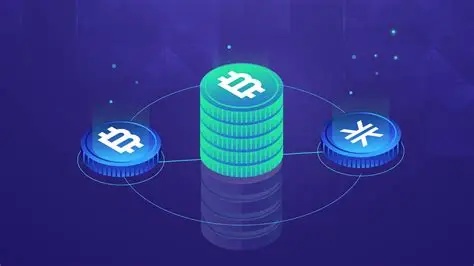This article will focus on the Differences Between Bridging Stablecoins and Bridging BTC, looking at the processes as they function across blockchain ecosystems.
Bridging stablecoins has lower costs, faster transfer speeds, and offers predictability in value. Bridging BTC, on the other hand, has higher fees and slower speeds, as well as volatile risks, but extends the utility of Bitcoin. Knowing the differences will assist users in deciding what to do.
What is Bridging Stablecoins?
Bridging stablecoins is the phenomena of transferring stablecoins across different blockchains. Stablecoins are cryptocurrencies whose value is pegged to a stable or reserve currency like the US dollar.

Stablecoins are useful as users can transfer digital assets across different blockchains without the assets losing value, and without the digital assets undergoing volatility that is often characteristic of cryptocurrencies.
Stablecoin bridges are mostly employed in decentralized finance (DeFi) for lending, trading, and providing liquidity, as they are cheap, reliable, and easy to use. Assets that are popular for bridging stablecoins include USDT, USDC, and DAI. They usually depend on cross chain protocols or smart contracts to complete the transfer.
What is Bridging BTC?
Bridging BTC is the transferring process of moving bitcoin from its original blockchain (Bitcoin network) to another blockchain which is often the case in decentralized finance (DeFi) or other cross-chain operations.

Bitcoin is often not compatible with other smart contract platforms like Ethereum or the Binance Smart Chain which is why zippered BTC as wrapped bitcoin (WBTC) is used to represent bitcoin on the destination blockchain.
This enables users to conduct BTC trades on different blockchains to lend or provide liquidity. BTC bridging is less efficient and more costly as compared to bridging stablecoins but it allows bigger Bitcoin utility across different blockchain ecosystems.
Key Differences Between Bridging Stablecoins and BTC
| Aspect | Bridging Stablecoins | Bridging BTC |
|---|---|---|
| Volatility | Low; value remains stable due to fiat peg | High; value fluctuates with Bitcoin market price |
| Transaction Fees | Generally lower fees | Higher fees due to Bitcoin network congestion |
| Speed | Faster transfers, often confirmed within minutes | Slower; confirmations take longer on the Bitcoin network |
| Use Cases | DeFi transactions, payments, liquidity provision | DeFi, trading, cross-chain investments |
| Security Risks | Risks mainly from smart contracts and bridges | Risks from smart contracts and potential BTC network delays |
| Popular Assets | USDT, USDC, DAI | BTC, WBTC, renBTC |
| Complexity | Simpler to bridge due to blockchain compatibility | More complex; often requires wrapped or pegged tokens |
How to Choose the Right Bridging Option
Look at transaction costs: While bridging to a stablecoin costs next to nothing, bridging BTC often comes at a premium and is highly subject to congestion.
Look at speed: In a hurry? Stable coins usually take your BTC and transfer it much faster than BTC.
Look at volatility: Bridging on BTC has price volatility. Stable coins maintain a constant price, and thus, much easier to work with.
Look at security: Always use a reputable bridge where the risk is minimized, whose smart contracts and bridges have been audited.
Decision on use case: Always use stablecoins for payment, investing in DeFi, or to provide liquidity. Bridge BTC when you aim to trade or use it for cross-chain investments.
Security Models and Risk Assessment
Smart Contract Bridges: These have a lower risk profile because they automate transfers. However, they risk bugs and exploits in the code.
Custodial Bridges: These rely on a trusted third party to hold and manage the assets. The risk comes from mismanagement of the assets and attacks on the custodian.
Federated or Multi-Signature Models: These require a set number of people to authorize the transaction. This reduces the risk of a single point of failure. However, the risk is the dishonesty of the parties controlling the validators.
Price Volatility: This is especially relevant in the bridging of bitcoin. The value of assets can change dramatically during the transferring process.
Audit and Reputation: You should always pick the bridges first with the audits done them and the bridges with the strongest reputational guarantees in the community.
Market Fluctuations: In this case, the failure of the transfer can itself cause a value drop due to network congestion.
Liquidity Considerations for Bridge Operations
Liquidity is a very important factor when it comes to using cryptocurrency because it determines the ease at which the assets can be moved across chains. Crypto bridges depend on reserves or liquidity pools to enable swaps.
If there is liquidity, there can be slippage, delays, or a complete transaction failure. Stablecoin bridges maintain large, stable liquidity pools so the transfers are smoother and more predictable. BTC bridging on the other hand can have more constraints as BTC is very valuable and is not always on some networks.
This tends to increase the transaction cost and the time it takes to complete the transaction. Users don’t have to guess liquidity levels because depth and the networks used are displayed for fast, cost beneficial operations.
Cost Analysis: Bridging Stablecoins vs Bitcoin
| Cost Component | Stablecoin Bridge | Bitcoin Bridge |
|---|---|---|
| Base Fee | 0.05 – 0.1% | 0.1 – 0.3% |
| Network Gas | $5 – $50 | $10 – $100 |
| Liquidity Cost | 0.01 – 0.05% | 0.05 – 0.2% |
| Total Cost | $10 – $75 | $25 – $200 |
Use Cases and Practical Applications
Cross-Chain Transfers – To engage in various ecosystems, move USDT and BTC across blockchains.
Decentralized Finance (DeFi) – Wrapping BTC allows access to DeFi trading markets, while stablecoins can be bridged for liquidity provisioning, yield earning, and lending/borrowing.
Payments and Remittances – As for stablecoins, they enable seamless and low-cost payments across borders.
Trading Opportunities – BTC bridging allows traders to arbitrage or margin trade, taking advantage of Bitcoin’s liquidity on non-native chains.
Hedging Strategies – Users protect against volatility by bridging stablecoins, or diversely use BTC.
NFTs and Gaming Ecosystems – Stablecoins are commonly bridged for use in purchasing NFTs or for use in gaming.
Pros & Cons Bridging Stablecoins and BTC
Pros & Cons Bridging Stablecoins
Pros
- Low transaction fees and predictable costs.
- Faster transfers across chains.
- Stable value, avoiding market volatility.
- Widely supported in DeFi, payments, and liquidity pools.
Cons
- Still vulnerable to smart contract exploits or bridge hacks.
- Limited to stable-value assets with no exposure to price gains.
- Dependence on liquidity availability in specific pools.
Pros & Cons Bridging BTC
Pros
- Extends Bitcoin’s utility beyond its native blockchain.
- Enables BTC participation in DeFi, lending, and trading.
- High demand and liquidity in cross-chain ecosystems.
- Can be useful for long-term holders seeking broader use cases.
Cons
- Higher fees and slower transaction speeds.
- Greater risk from volatility during transfers.
- Often requires wrapped or custodial solutions, adding trust risks.
- Less predictable costs compared to stablecoins.
Conclusion
Bridging stablecoins and bridging BTC serves different roles in the crypto ecosystem and has its unique benefits and tradeoffs as well.
Stablecoin bridges have speed and low fees with predictable value, focusing on payments, DeFi participation, and cross-chain liquidity transfers. Bridging BTC, however, has much higher costs and offers slower speeds and much greater volatility risk, while enabling DeFi and cross-chain trading on BTC’s bridging the utility over its native chain.
In the end, the right choice is based on your objectives. If you seek efficiency and stability, stablecoins is your best bet. If you want BTC for long-term value exposure and greater participation in the ecosystem,. Informed decisions make cross-chain operations much more cost-effective and safer.
FAQ
What is the main difference between bridging stablecoins and BTC?
Stablecoin bridging provides fast, low-cost, and stable transfers, while BTC bridging allows Bitcoin to be used across different blockchains but involves higher fees, slower speed, and volatility.
Which is cheaper to bridge, stablecoins or BTC?
Stablecoins are generally cheaper due to lower network and liquidity costs, while BTC bridging often requires higher fees because of Bitcoin’s slower and more congested network.
Is bridging BTC riskier than bridging stablecoins?
Yes, BTC bridging carries more risks due to volatility, complex wrapping mechanisms, and potential custodial reliance. Stablecoin bridges face risks too but are usually more predictable.
When should I choose stablecoin bridging over BTC bridging?
Choose stablecoins for payments, DeFi participation, and fast cross-chain liquidity transfers. BTC bridging is better suited for traders or those wanting to deploy Bitcoin in non-native ecosystems.
Are there security risks in both bridging methods?
Yes, both carry risks such as smart contract exploits, bridge hacks, or liquidity shortages. However, BTC bridges often involve additional custodial or wrapped-token risks compared to stablecoins.










